First Storey
Rear Courtyard Topics
First Storey Topics
Kulikah
Location Description

As you enter the rear courtyard, either from the Chinatown Kreta Ayer Square, or exiting from the Universal Wisdom Hall towards the rear, you will see at the top of the stairs, the flaming Kulikah, representing Acala. Below this on the central portion of the stairs, you will see another flaming dragon carved in granite.
About Kulikah in BTRTM
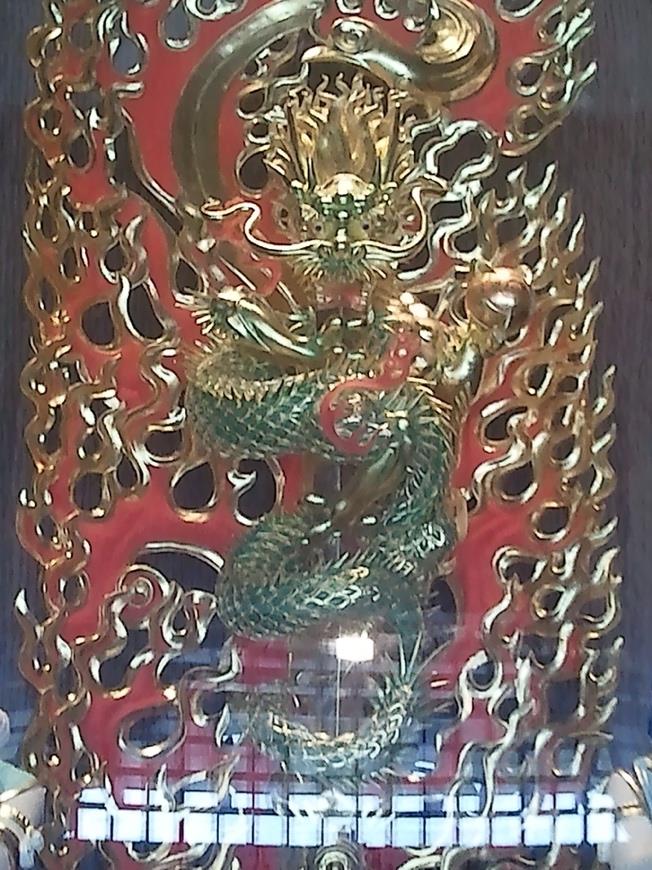
This depiction of a majestic dragon coiling around a sword is Kulikah, the manifestation of Acalanatha, one of the Five Vidyarajas (Wisdom Kings or Kings of Mystical Knowledge) of Esoteric Buddhism. "Acala" means unmovable in Sanskrit, steadfast in his faith in the Dharma. Acalanatha is the emanation of Buddha Vairocana and is usually depicted in ferocious and menacing expressions, representing His wrath against ignorance and evil, hoping to subdue evil and frighten stubborn and ignorant people into accepting Buddhist teachings.
At a grand height of 2.85 metres, Kulikah is depicted as a finely-carved Chinese-styled flying dragon twirling himself three times around a thick vertical double-edged, single-handed straight sword with his head posturing above the sharp point of the sword. Staring ahead with two bulging eyes, he opens his mouth as if to devour the sword and his tongue touches the tip of the sword. An aureole of intense fire forms a dramatic background.
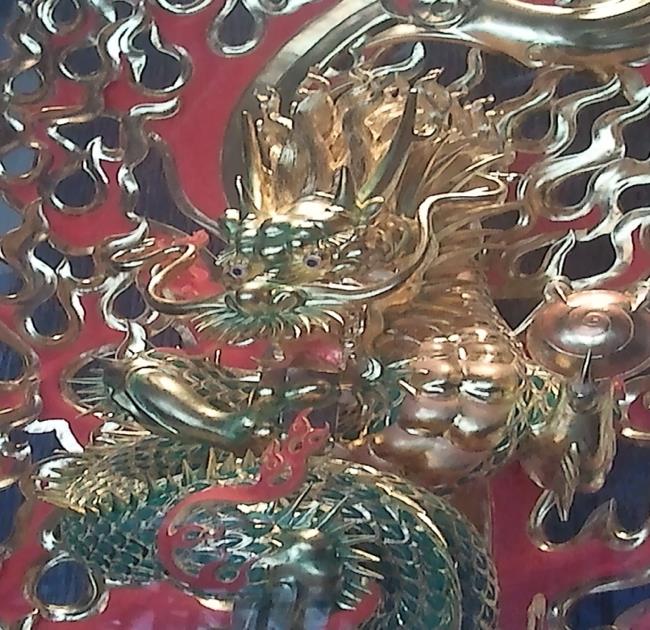
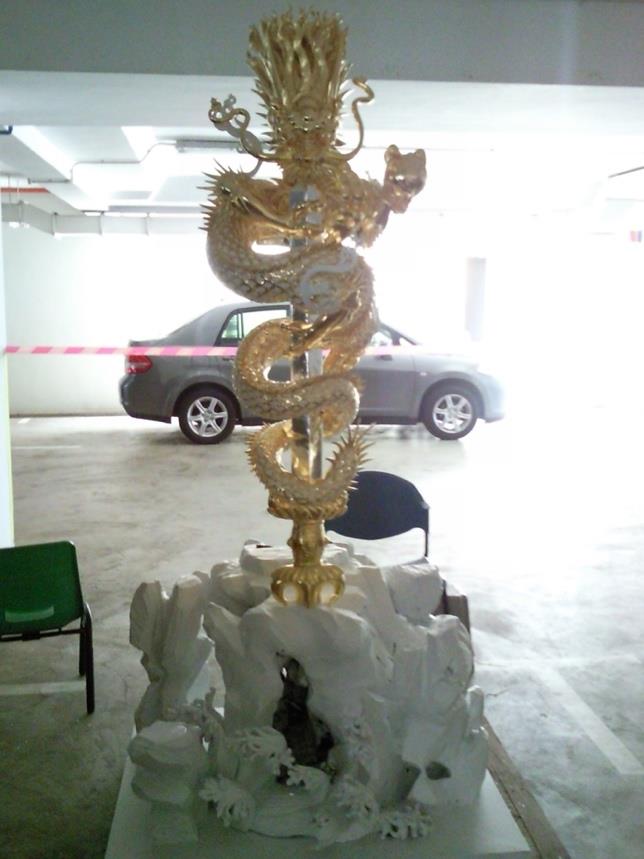
Two two-pronged vajras constitute the sword's guard and pommel (the top and bottom ends of the grip) with the pommel half-buried in a rock.
The dragon sports two long flying whiskers and numerous shorter whiskers. He has four antlers (two long and two short) and clutches the sword with the powerful claws of his three limbs. The fourth (his left front limb) grasps onto a spherical golden jewel carved with a spiral pattern. He has a golden green scaly armoured body with spikes protruding from his vertebral column.
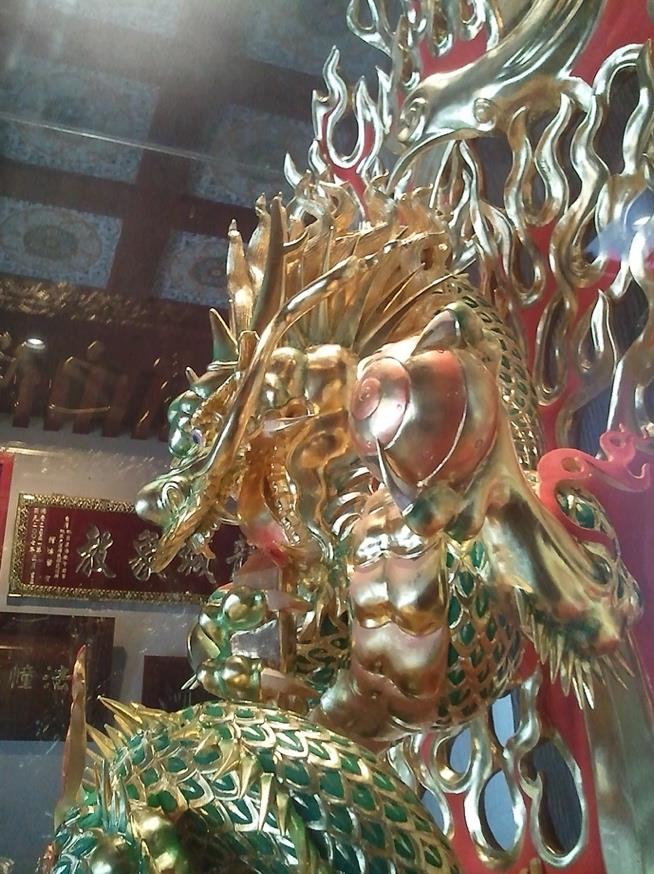
Kimbara, who stands on Kulikah's left, is shown as a 1.43 metres tall, fair-skinned, barefooted young boy with long dark blue hair covering parts of his ears. He stands upright, resting his weight on his left leg. His two hands display the anjali mudra (prostration hand gesture) at the level of his chest. He is half-naked with three heavenly scarves draped over his body and wears golden bracelets, anklets, and necklace. He is clothed in an orange gold-patterned skirt knotted on the right of his waist which flows down to his shins. Folded back around his waist, the skirt reveals an inner lining of light blue material. Between his thumbs and index fingers, he holds a long single-pronged vajra.
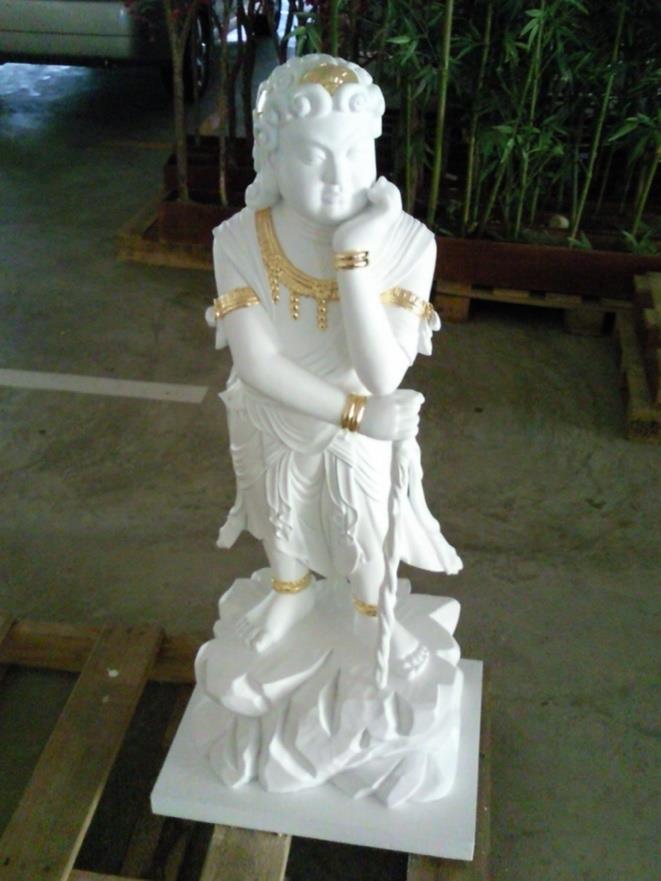
To Kulikah's right is Cetaka who, at 1.14 metres tall, is also presented as a young boy similar to Kimbara, i.e., wearing similar scarves, skirt, bracelets, necklace and anklets, etc. His main differences are: his light purple skirt is mainly decorated with golden diamond shaped patterns with a lining of light pink material; the skirt is knotted in front, at the level of his belly button; he supports his chin with his left hand which in turn is supported at the elbow by his right hand holding a wooden long staff; his hair is wavier, forming many spiral locks from which reveal a golden tiara. He stands erect, resting his weight on his right leg.
Both are expressionless with long earlobes, slender curving eyebrows and finely pursed red lips.
All three figures are depicted on top of moss-covered rock formations featuring milk-white lichens.
About Kulikah
Symbolically, Acala is also represented by his sword of wisdom Kulikah (Kulika, Japanese: Kurikara) to destroy illusions; or as a naga or dragon coiled around a sword and biting the sword tip, surrounded by flames.
The portrayal of Acalanatha as Kulikah is derived from the "Sutra that illustrated the Kulikah Naga defeating the practitioner of unorthodox ways". During one of the rhetoric discussions, Acalanatha transformed himself into a flaming sword and the unorthodox practitioner immediately mimicked him and transformed himself into a similar flaming sword. The next thing that happened was that Acalanatha transformed again into a naga, this time he swallowed his opponent completely, gave out a cry equivalent to two trillion thunders, sending jolts of panic and terror to the evil beings and unorthodox practitioners and finally, persuaded them to accept Buddhist teachings.
Kulika is also considered one of the Eight Nagarajas (Naga kings).
About Acala in BTRTM
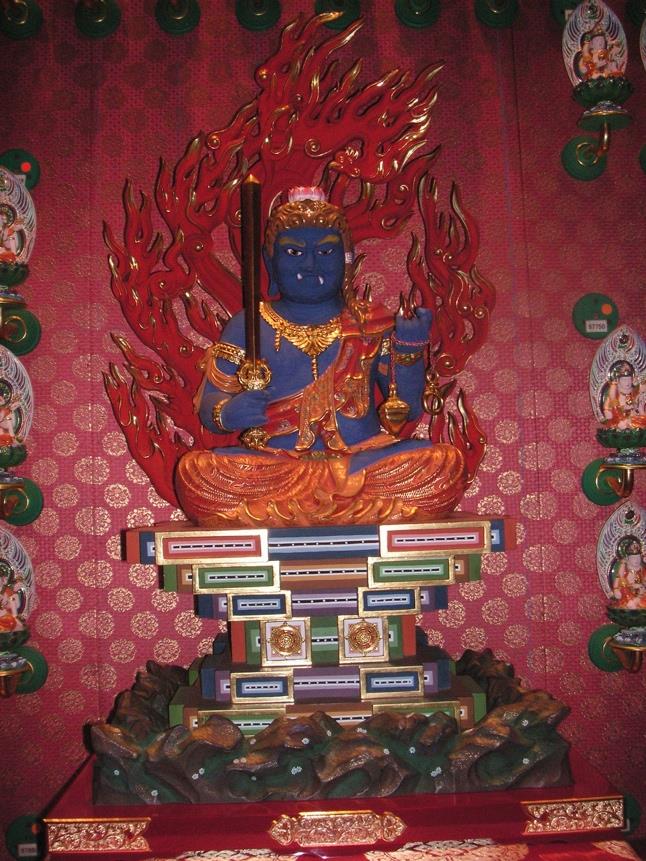
An example of Acala is seen at the Universal Wisdom Hall as one of the Zodiac Protectors for those born in the year of the rooster.
He holds vertically in his right hand a double-edged sword with a three-pointed vajra handle to combat the 3 poisons of greed, anger and ignorance. On the sword winds a dragon surrounded by flames. In his left hand, he holds a rope lariat or lasso with a hook or two pointed varja at each end (to catch and bind evil forces to prevent them from doing harm). He has a blue body clad in monastic rags, with a wrathful face and a pronounced squint, has one fang pointing up and another pointing down, and a braid on the left side of his head. His halo of flames is to consume all troubles.
About Acala
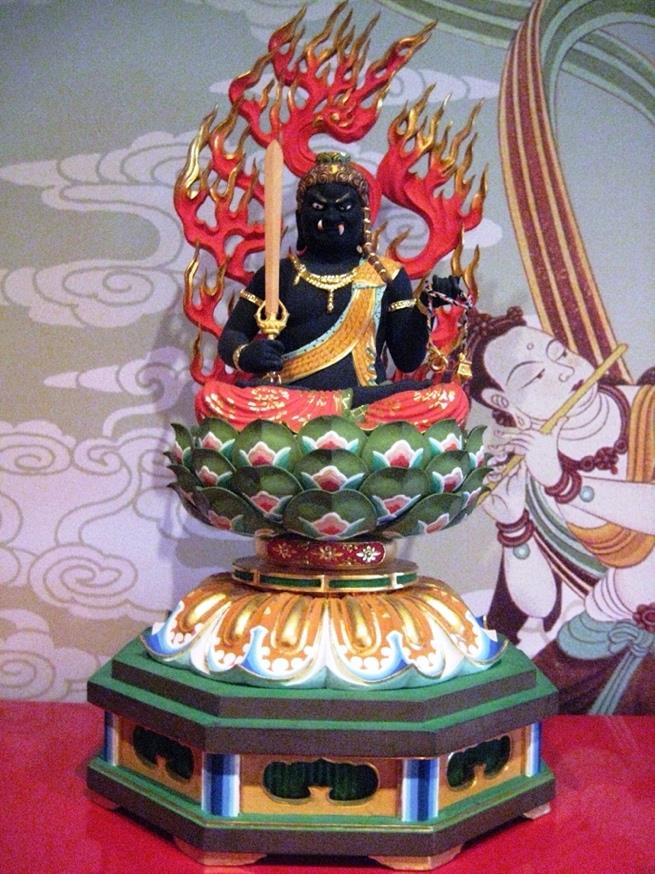
Ācala or Achala (Sanskrit: Achala or Acalanātha (अचलनाथ) in; Āryācalanātha, Ācala-vidyā-rāja and Caṇḍamahāroṣaṇa; Chinese:不動明王, Búdòng Míngwáng; Japanese: 不動明王, Fudo Myo-O, Joju Kongo, Mongolian: Хөдөлшгүй: Tibetian: མི་གཡོ་བ) refers to the "Immovable Wisdom King", and is the best known of the Five Vidyarajas (Wisdom Kings, Kings of Mystical Knowledge, Kings of Light) of the Womb Realm. The Sanskrit term ācala means "immovable"; Ācala is also the name of the eighth of the ten completion stages of the Bodhisattva path (the Eighth Bhumi). His siddham seed-syllabe is "hāṃ". He is one of the Krodharajas, the Lords of Wrath.
He is considered as a body of metamorphosis (Nirmanakaya) of Vairocana Buddha. He is the symbolic protector of Buddhism, essentially incarnating Prajna Immovable for sentient beings.
Acala is mentioned extensively in THE VAIROCANĀBHISAṂBODHI SUTRA (Mahāvairocana-abhisaṃbodhi-tantra), as follows:
Fascicle One, "Below the mantra-lord (i.e., Vairocana), in the direction of Nairṛti (i.e., southwest), Is Acala, the Tathāgata's servant: he holds a wisdom sword and a noose, The hair from the top of his head hangs down on his left shoulder, and with one eye he looks fixedly; Awesomely wrathful, his body [is enveloped in] fierce flames, and he rests on a rock; His face is marked with [a frown like] waves on water, and he has the figure of a stout young boy."
Fascicle Two, "Next, I shall now explain the quelling of all obstacles. One thinks on the ferocious and very powerful Acala with his mantra Dwelling in his own maṇḍala, or else the practitioner [himself] dwells therein. He visualizes an effigy [of the obstacle] with [Acala's or his own] left foot placed on its head: The obstacle will be eliminated and extinguished, not to arise [again]."
Fascicle Three, "Acalananta, seated on a stone, holding a noose and a wisdom sword in his hands, encircled by a wreath of flames, and threatening obstructors; alternatively, he places his seal or writes his syllable, namely, the letter Hāṃ."
Fascicle Four, "Make a fist with the left hand, extend the middle finger and forefinger, and place the thumb on top of the little and ring fingers; extend the forefinger and middle finger of the right hand, insert them in the left palm, and again place the thumb on top of the little and ring fingers, just like in the sheath of a sword: this is the seal of Acalanātha."
Fascicle Five, "The maṇḍala of Acala has both a circle of wind and of fire; He is in the direction of Nairṛti (i.e., southwest), below the Tathāgata Vairocana, Surrounded by seed[-syllables], and a sublime great wisdom sword, Or a noose seal he who possesses wisdom lays out."
"Fudō converts anger into salvation; has furious, glaring face, as Fudō seeks to frighten people into accepting the teachings of Dainichi Buddha; carries "kurikara" or devil-subduing sword in right hand (representing wisdom cutting through ignorance); holds rope in left hand (to catch and bind up demons); often has third eye in forehead (all-seeing); often seated or standing on rock (because Fudō is "immovable" in his faith). Fudō is also worshipped as a deity who can bring monetary fortune. Also, Fudō's left eye is often closed, and the teeth bite the upper lip; alternatively, Fudō is shown with two fangs, one pointing upward and other pointing downward. Fudō's aureole is typically the flames of fire, which according to Buddhist lore, represent the purification of the mind by the burning away of all material desires. In some Japanese sculpture, Fudō is flanked by two attendants, Kongara Dōji and Seitaka Dōji."
Mantra
Fascicle Two, "Acalanātha: Namaḥ samanta vajrāṇāṃ, caṇḍamahāroṣaṇa spho-ṭaya hūṃ traka hāṃ māṃ. (Homage to all Vajras! O you who are violent andvery wrathful! rend! hūṃ traka hāṃ māṃ!)"
The mantra of Acalanātha: Namaḥ samantavajrāṇāṃ, hāṃ. (Homage to all Vajras! Hāṃ!)
About Kumaras
Acala or Kulikah is usually flanked by two kumaras or mahakumaras (child attendants or acolytes), Kimkara (Kinkara, Japanese: Kongara Doji) and Cetaka (Japanese: Seitaka Doji). Kumaras are divine boys between the ages of 8 and 20, who serve as attendants to other deities, notably Acala. Some art show Acala attended by 2, 3, 5, 8 (Eight Great Youths), 36 and even 48 kumaras.
Usually, on Acala's left stands Kimkara, with his palms closed, holding a single-pronged pestle between his hands and dressed in cascading heavenly robes. Cetaka, on the other hand, the child attendant depicted on his right, is holding onto a vajra staff and dressed in the same heavenly robes. Kimkara is usually depicted in pale white skin colour, an embodiment of compassion to worshippers of Acalanatha, while Cetaka is depicted in red skin colour, an indication of his wrath to discipline erring followers in mending their ways.
About Art
He usually holds in his right hand a double-edged sword with a three-pointed vajra handle vertically (to combat the 3 poisons - greed, anger and ignorance) which winds a dragon surrounded by flames and in his left hand a rope lariat or lasso with a hook or two pointed varja at each end (to catch and bind evil forces to prevent them from doing harm). He has a blue body clad in monastic rags, a wrathful face with eyes glaring angrily, a pronounced squint, teeth are bared, with one fang pointing up and another pointing down, and a braid on the left side of his head. His halo of flames is to consume all troubles.
His statues are generally placed near waterfalls and deep in the mountains and in caves. Acala is usually accompanied by eight child acolytes, of whom Kongara (Kinkara) and Seitaka (Chetaka) are often shown close to him.
The above Kulikah statue (TB031) is displayed at the mezzanine floor in our Eminent Sangha Museum. It is a smaller version with the main difference being the bodily posture of the dragon: its body is coiled around the sword upside-down with its tail at the top and its head at the bottom, looking back upwards.
Development of BTRTM Kulikah
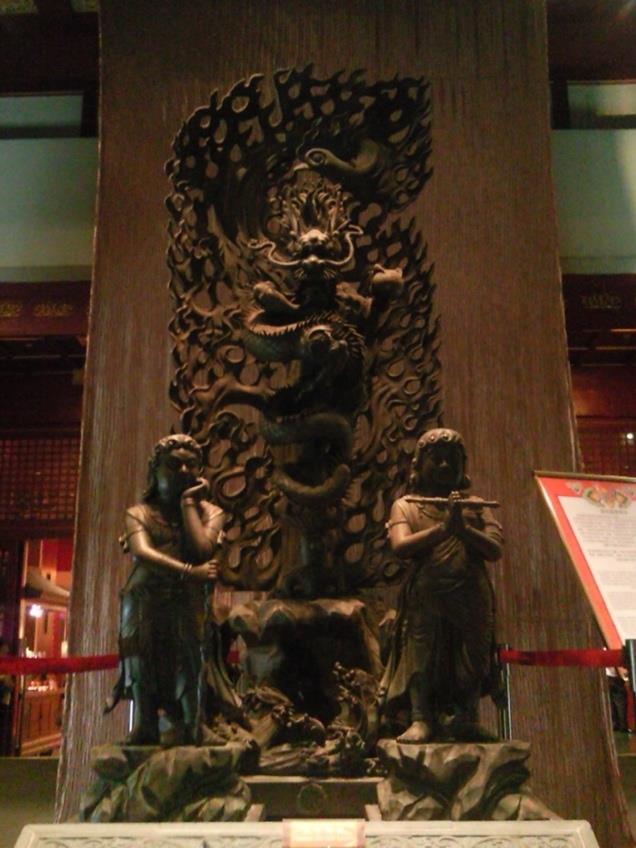
This was one of the large artifacts purchased from The House of Destiny for the museum. It was exhibited at the 2004 Singapore Expo exhibition.
The Chief Monk felt that it should be placed in a more prominent place and finally decided on the present location.
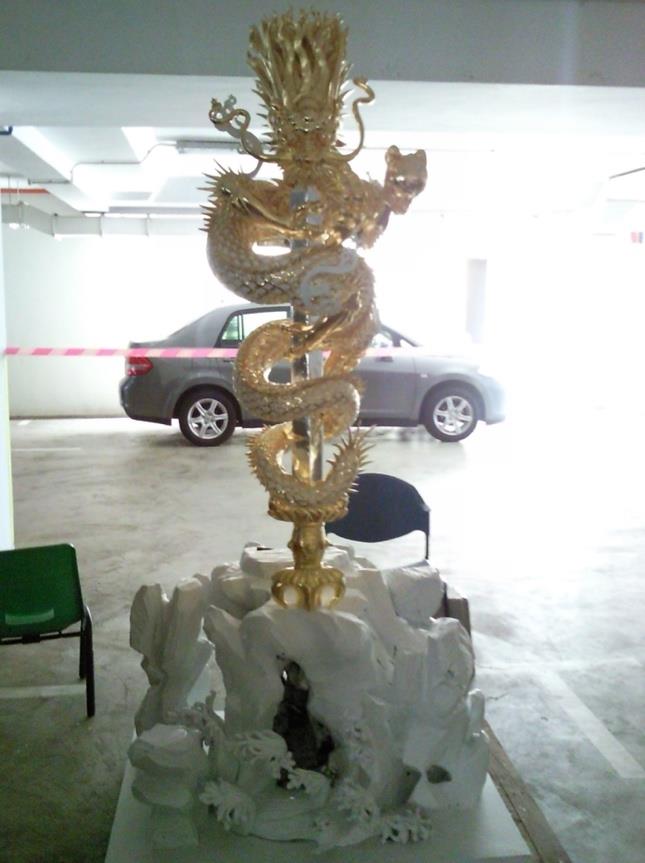
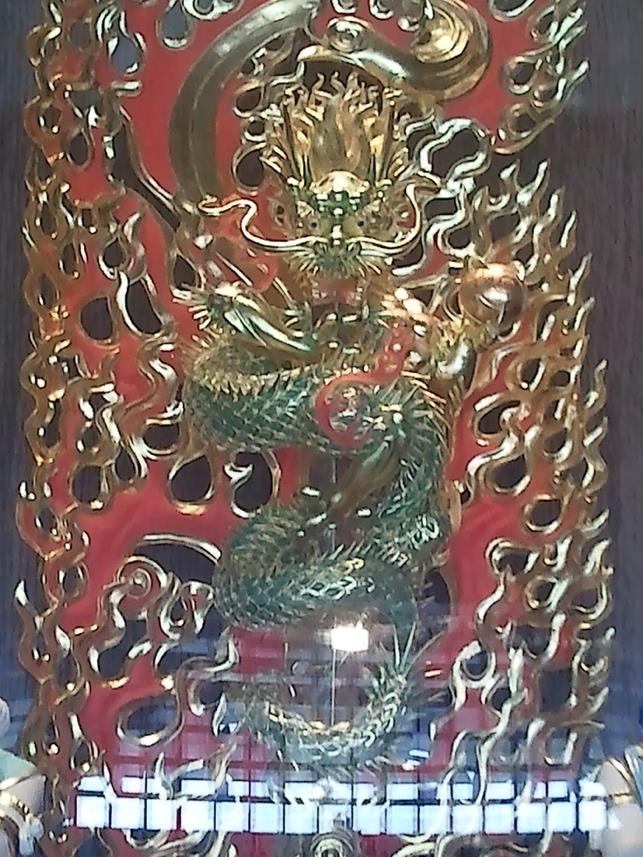
The artists from Shanghai You Shan Guan Decorative Design Co Ltd, led by Mr Zhang Jian, were commissioned to paint the artifact to allow it to blend in with the BTRTM Tang architectural art style.
Bibliography:
Lokesh Chandra, Dictionary of Buddhist Iconography, International Academy of Indian Culture and Aditya Prakashan, 1999, Vol 1, pages 1751 - 1752 (Kulika)
Lokesh Chandra, Dictionary of Buddhist Iconography, International Academy of Indian Culture and Aditya Prakashan, 1999, Vol 1, pages 29 - 72 (Acala)
Lokesh Chandra, Dictionary of Buddhist Iconography, International Academy of Indian Culture and Aditya Prakashan, 1999, Vol 1, pages 1752 - 1753 (Kumara)
Louis Frederic, Buddhism, Flammarion Iconographic Guides, 1995, ISBN 2-08013-558-9, pages 203 - 208
William Edward Soothill and Lewis Hodous, A Dictionary of Chinese Buddhist Terms, Motilal Banarsidass Publishers, 2000, ISBN 81-208-0319-1, pages 104 - 105
Meher McArthur, Reading Buddhist Art, An Illustrated Guide to Buddhist Signs & Symbols, Thames & Hudson,2002, page 70 - 71
Denise Patry Leidy, Shambala, The Art of Buddhism, An Introduction to its History & Meaning, 2008, pages 214 - 215
Giles Begun, Buddhist Art, An Historical and Cultural Journey, River Books, 2009, page 362